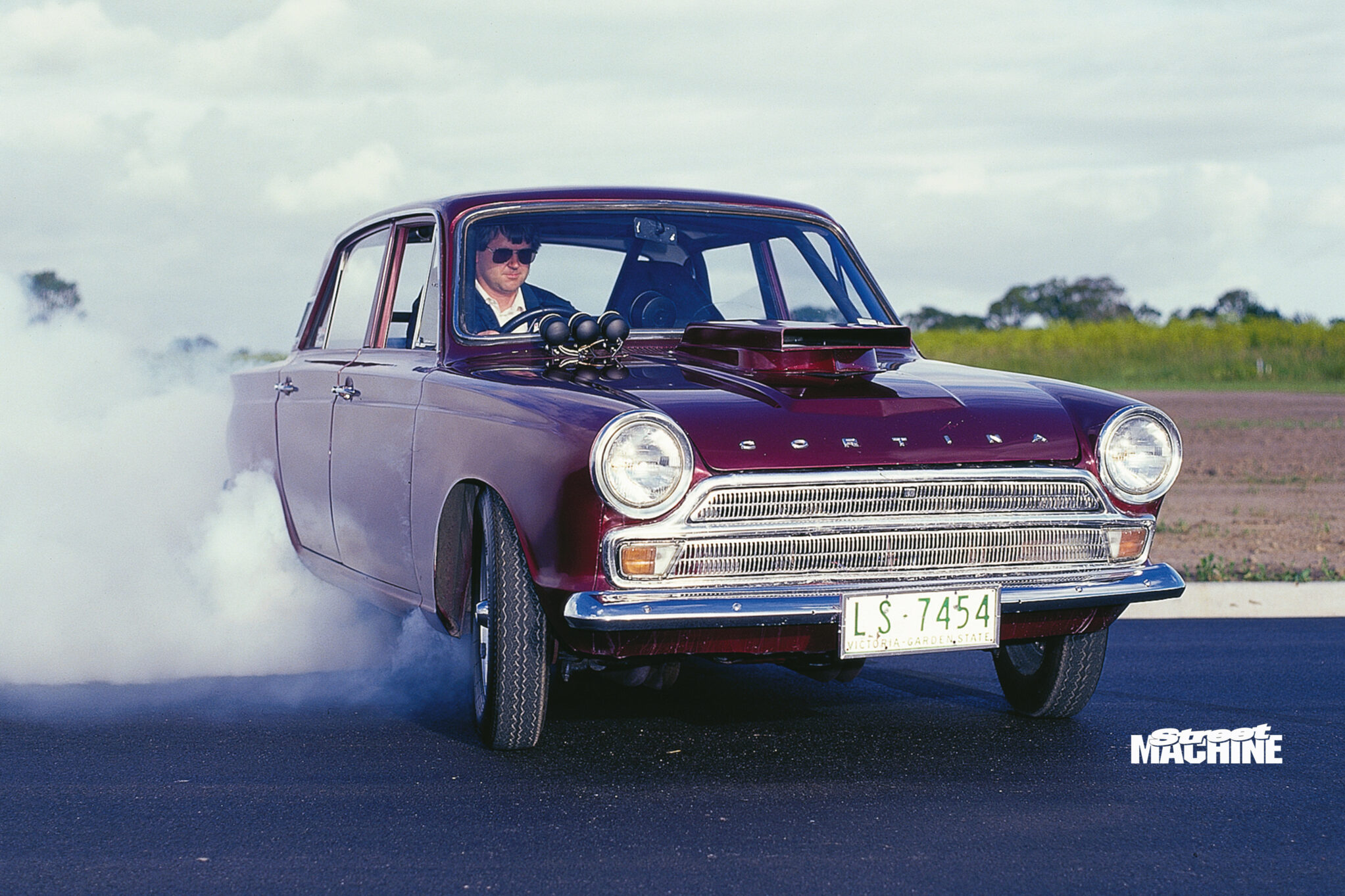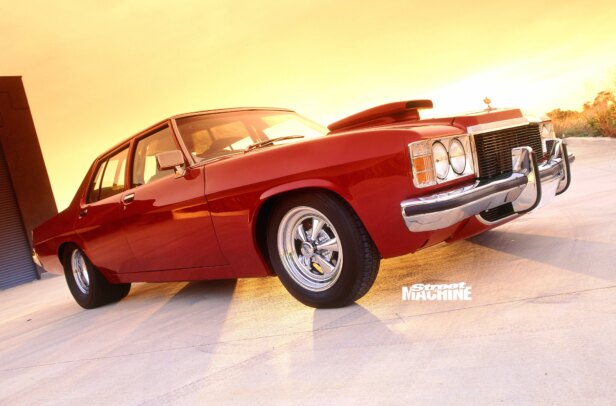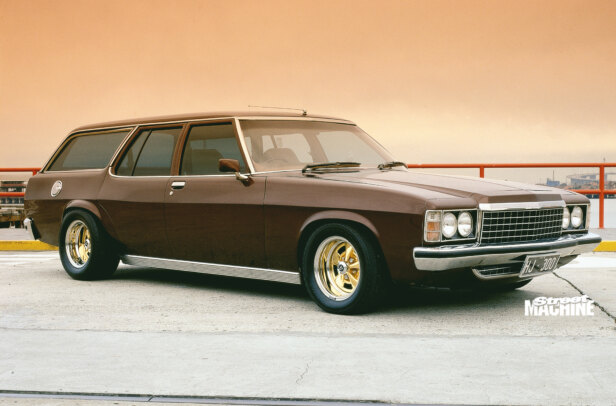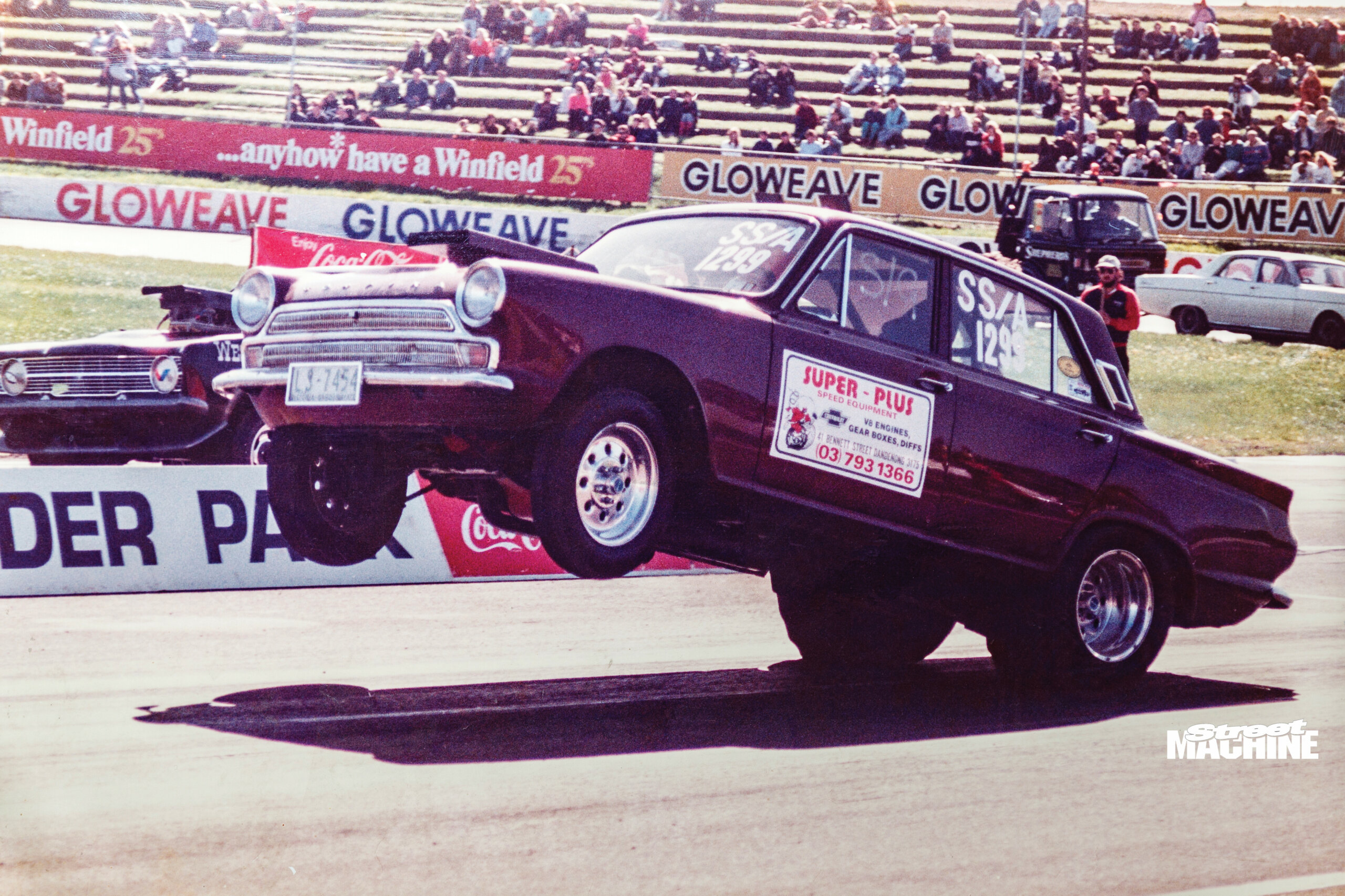This story on Geoff and Robin’s HJ was first published in the March 1990 issue of Street Machine
Okay guys, the pub talk stops right here. This is Australia’s quickest street car. And it’s official — no backroom bullsh*tting. This black beauty HJ owned jointly at the time by Robin Waite (the car itself) and Geoff Paton (the heavy-hitting driveline), won the Australian Street Machine Drag Racing Championships held back in November [1990] at Calder Park.
It’s time? A fastest of 10.239 secs qualifying — on street tyres!

Robin and Geoff didn’t only shatter a few records, they obliterated a few myths too. An HJ (and a four door no less) is too big and heavy to run 10 second passes, isn’t it? That’s why we asked Geoff to tell us how they did it.
But before we do that, we’ll give those of you who aren’t familiar with Geoff’s achievements a quick run down on his past. What Geoff doesn’t know about getting a street car to kick serious freckle out on the drag strip hasn’t been invented.


For starters, he’s head honcho of wholesale engine part specialists, Victorian Speed-Pro Distributors. But it’s this bloke’s hot car history that tells the real story. His first car a small-block-powered LX Hatchback ran 12.78/116 on street tyres but it was soon followed by a strip only 396 cube Chev Nova and a Chev 400 EH which turned 11.8s.
Then there was King Rat which we featured in our Aug-Sep ’85 issue. The street rego’d, big-blocked rapid little rodent ran a slick-shod 9.9 secs at 137 mph. But for Geoff, better was to come. His next car, again a big-blocked monster, was a mega-tough Mark I Cortina. Featured as Animal Acts back in March ’86, Geoff’s Cortina established a national Super Sedan record (on slicks) of 9. 52/146.7, but on an all-out run did a best time of 9:2. Yep, that thing was quick!

But after a run of small bodied, big performance rockets, why did the guys pick on HJ? “Sure, many people told us at the time we were crazy, but to start with, it was readily available to us — we didn’t have to find it. The car already had a 396 big-block Chev, the cooling system was good and the Ford nine inch diff wasn’t about to drop off when it got a dose of power.”
That’s all Goeff needed to unleash the musclebound bored 482 cube Chev mill that first appeared in his Torana hatch. Not surprisingly, the alloy big-block is bulging with heaps of Speed-Pro gear — pistons, rings, pushrods, lifters, valves (2.19 inch intake, 1.88 inch exhaust), oil pump — as well as Michigan 77 bearings. Crower conrods, ARP bolts and an unspecified Crane cam.

Heads are trick alloy Chev D-port items machined by Automotive Performance Engineering, while the huge Holley 1150 cfm Dominator carb sits atop a Weiand manifold. Setting it all alight is the job of a Vertex magneto, while the Pacemaker extractors chuck out the exhaust crap. KB Transmissions was responsible for the A1 shiftkitted Powerglide tranny, GJ Drivelines spec’d the tailshaft, while Supa Trik Engineering did a top job on the 4.11 geared nine-incher.
While Robin and Geoff admit the car’s never gonna give the show scene a shake, David, Craig and Joey at AA Smash Repairs at Dandenong did a good job with the HJ’s blacker-than-black panels.
Inside, it’s stock Munro except for a Raid Turbo twirler and the Auto Meter water temp, fuel and oil pressure gauges.

So what makes this combination such a potent street/strip weapon? We asked Geoff to divulge a couple of secrets…
“Weight is only a problem if you can’t make it work for you. The critical part about racing with street tyres is traction. The race is won and lost at the start line. Anyone with street racing experience knows how hard it is to pull back a car which has got a break on you.
“Traction is related directly to weight. The more weight you have on a tyre the more traction you’ll get from that tyre. In our case, the Holden’s 3350 lbs is turned to our advantage by loading up the rear tyres. Anyone who saw the car at Calder Park knows how hard and straight the HJ launches.”
Geoff says the HJ’s standard suspension was another plus factor when it came to getting the jump off the line. As he explains, the fastest launching cars in drag racing are the four link suspended Pro-Stockers. And have a guess what sort of suspension a stock as a rock Holden HQ-HZ Monaro has? That’s right — four link!

“There it is under the car waiting to be used.” Geoff says. “Our HJ used the original pick-up points and locating arms (they were boxed to prevent buckle under load). All we did was change the bushes to give
different deflection characteristics so there wouldn’t be too much shock loading on the tyres.
“Tuning the suspension to give maximum bite is the trick. If you get it right, a heavy car will do the job better for you as the extra weight will create more traction at the rear tyres.” To help with this, the boys opted for Bilstein 90/10 shockers under the front end.

But how about the sheer size of the thing? Geoff Paton again:
“Actually this is a benefit because you can fit a Chev big-block into a HQ-WB and If looks like the Holden factory meant it to be there. There’s plenty of room for a big radiator and extractors, and a low manifold fits under the bonnet.
“Sure, a big car does have more air resistance than a small car, but just how important is this? I’ve seen articles about the air resistance of motor cars and although I don’t remember the exact figures, I know air resistance only starts to become a really heavy load above 150 mph. As most street tyre races are usually won or lost well below 130 mph, I don’t think size is very important. If the extra size means you can fit a big-block, the extra horsepower is easy to find to push the car through the air.”

Geoff says the beauty of any big-block, whether it be Ford, Chev or Chrysler, is that horsepower is made easily once a little work is done. With so many parts available, it’s simple to take full advantage of the horsepower potential.
“This relates to the weight penalty of a big car like the Holden,” Geoff continues. “The extra weight needs more horsepower to push it at higher speeds when there’s no longer a problem with traction. At those sort of speeds (60-80 mph) a big-block really comes into its own with more horsepower available to give that sucker a good top end.”
Geoff reckons size has other advantages, such as a longer wheelbase. “The longer the wheelbase, the more stable the car is if it loses traction. Look at Top Fuel dragsters. They’re incredibly long, mainly to give better stability. A short wheelbase car is less stable and harder to correct when it gets out of shape.”

Geoff reckons the HJ is noticeably more stable than either of his previous cars — Torana and Cortina — tending to move almost instinctively to the centre of the track. He says stability is important if you want to watch your opponents during the quarter-mile blast…
“I have to confess that most of the time during the race I’m looking back at the other guy,” Geoff admits. “A big, gentle handling car like the Holden HJ gives you confidence to take your eyes off the road — something I could never do in the Torana.”
Bigger is also better when it comes to stuffing the wheelwells with serious rubber. But even with the size of the HJ, Geoff says he could’ve done with even more bag space: “Our HJ can only take a 275/50 tyre and even then they rub on the guards if we’re not careful. Smaller cars almost always need drastic surgery to the wheel arches to fit anything heavy duty.”
What Geoff’s shown us is that you can come up with what some people would reckon is the ‘wrong’ combo and still come up trumps.
ROBIN WAITE/GEOFF PATON
1975 HOLDEN HJ
| ENGINE: | |
| Capacity: | Chev 482 |
| Induction: | Holley 1150 Dominator |
| Blower: | – |
| Intake man.: | Weiand |
| Heads: | Chev D port |
| Cam: | Crane |
| Pistons: | Speed-Pro |
| Crank: | Stock |
| Ignition: | Vertex Magneto |
| Exhaust: | Pacemaker extractors |
| DRIVELINE: | |
| Trans.: | Powerglide |
| Diff: | Supa Trik nine inch 4.11 gears |
| SUSPENSION & BRAKES: | |
| Springs: | Custom stock |
| Shocks: | 90/10, custom |
| Front brakes: | Stock discs |
| Rear brakes: | Ford drums |
| WHEELS & TYRES: | |
| Front tyres: | M&H 205/60 x 15 |
| Front wheels: | Cragar 15 x 7 |
| Rear tyres: | M&H 275/60 x 15 |
| Rear wheels: | Cragar 15 x 8 |
| Paint: | Black |
| Build time: | Three weeks |



Comments